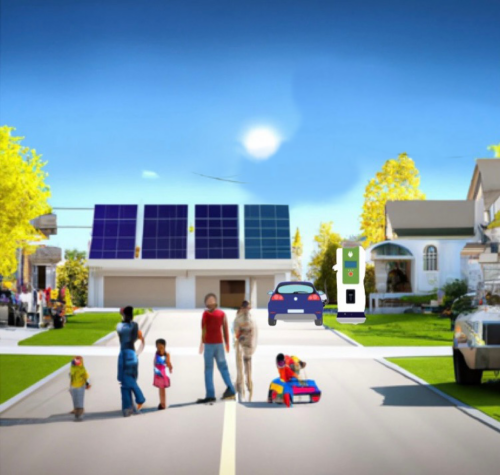The Inflation Reduction Act (IRA), signed into law by President Biden in August 2022, is designed to help fight inflation, increase investment in domestic manufacturing and energy production, lower prescription drug prices, and sharply reduce carbon emissions by 2030.
It also included new and expanded tax incentives designed to reward individuals and businesses for making clean energy investments, and while there are multiple savings opportunities, clean energy efforts are the most highly rewarded. In 2023, there are several credits you may want to consider as part of ongoing tax planning. Here are a few of the top highlights.
Clean vehicle tax credit
Under new regulations, the $7,500 tax credit for the purchase of eligible EVs has been extended until 2032. For a vehicle to qualify, it must have a battery capacity of at least 7 kilowatt hours, weigh less than 14,000 pounds, and be made by a qualifying manufacturer. In addition, it must undergo final assembly in North America.
It’s important to know the sale only qualifies if the vehicle is purchased new, and the seller reports the required information to the IRS (buyer’s name and Taxpayer Identification Number). Also, there are adjusted gross income (AGI) thresholds that may limit qualification of the credit. Finally, the manufacturer’s suggested retail price (MSRP) cannot exceed $80,000 for vans, sport utilities, and pickup trucks, and $55,000 for all other vehicles.
Used clean vehicle credit
If you prefer to purchase a pre-owned vehicle, there’s good news for you, too. There’s also a $4,000 maximum credit available for the purchase of used clean vehicles starting in 2023. The credit is available for the purchase of used qualified electric vehicles (EVs) or fuel cell vehicles (FCVs) made from a licensed dealer. The cost of the vehicle may not exceed $25,000, and the credit is equal to 30% of the sales price (limited to $4,000).
To qualify, the vehicle must have a model year at least two years older than the current year, have a gross vehicle weight of less than 14,000 pounds, and have a battery capacity of at least 7 kilowatt hours. As with a new vehicle purchase, there are AGI restrictions for this credit as well. Finally, it’s important to note the dealer must report the required information to the IRS at the time of sale.
Commercial clean vehicle credit
This $40,000 maximum credit is available to businesses and non-profits that purchase an eligible commercial clean vehicle. To qualify, the vehicle/machinery must either be a plug-in electric vehicle that draws propulsion from an electric motor, or a qualified commercial fuel cell motor vehicle. The battery requirement for gross vehicle weight under 14,000 pounds is 7 kilowatt hours, and for vehicles that exceed this weight, 15 kilowatt hours.
The credit is equal to the lesser of 15% of the basis in the vehicle (30% if powered by gas/diesel) or the incremental cost of the vehicle. The maximum credit amount is $7,500 for those weighing less than 14,000 pounds and $40,000 for all others. And, there’s no limit on the number of vehicles an organization may claim the credit for.
Construction and building improvements
There’s good news for construction companies, real estate investors, and homeowners as well – those investing in ground-up construction or improvements to their existing buildings may benefit as well.
Section 179d expansion
The Inflation Reduction Act also made several changes to the deduction companies can now claim, including an increase in the deduction amount up to $5 per square foot. For projects that meet prevailing wage and apprenticeship standards, the amount will vary between $2.50 to $5.00 per square foot, and for others, the amount will range between $.50 and $1.00 per square foot.
There’s also a change that allows non-profits and tribal governments to claim the deduction on eligible projects. Finally, the rules were changed to allow the maximum deduction every three years on commercial properties and four years on non-profit and other buildings.
Residential clean energy credit
This 30% tax credit is available for certain eligible expenses made in energy-efficient residential property. The Act extended the credit through 2034, increased the rate to 30%, and expanded qualifying expenses. Examples of eligible expenditures include solar panels, solar water heaters, fuel cell property, wind turbines, geothermal heat pumps, and battery storage technology expenses.
And, it’s important to note the credit applies to property placed in service after December 31, 2021, and prior to January 1, 2033. The amount gradually reduces to 26% in 2033, 22% in 2034, and is not available in 2035.
Energy-efficient home improvement credit
Originally scheduled to phase out at the end of 2023, this tax credit has been extended. The amount of the credit is equal to 30% of qualified expenses incurred during the year and includes certain energy efficiency improvements, residential energy property expenses, and home energy audits. The credit is limited to certain dollar amounts depending on the item installed There are several types of improvements that qualify:
Building Envelope – This includes certain exterior doors, windows/skylights, and insulation and air sealing materials. Depending on the item installed, the credit caps out between $250 to $600.
Residential Home Energy Property – This includes certain central air conditioners, natural gas and oil water heaters, natural gas, and propane furnaces, and improvements of panelboards or branch circuits installed along with building envelope components. The available credit amount is 30% of costs of the item installed.
Heat Pumps/Biomass Stoves – This includes electric or natural gas heat pump water heaters, electric or natural gas heat pumps, and biomass stoves and boilers. The available credit amount is 30% of costs, including labor.
For more news on the Inflation Reduction Act: https://www.irs.gov/inflation-reduction-act-of-2022



